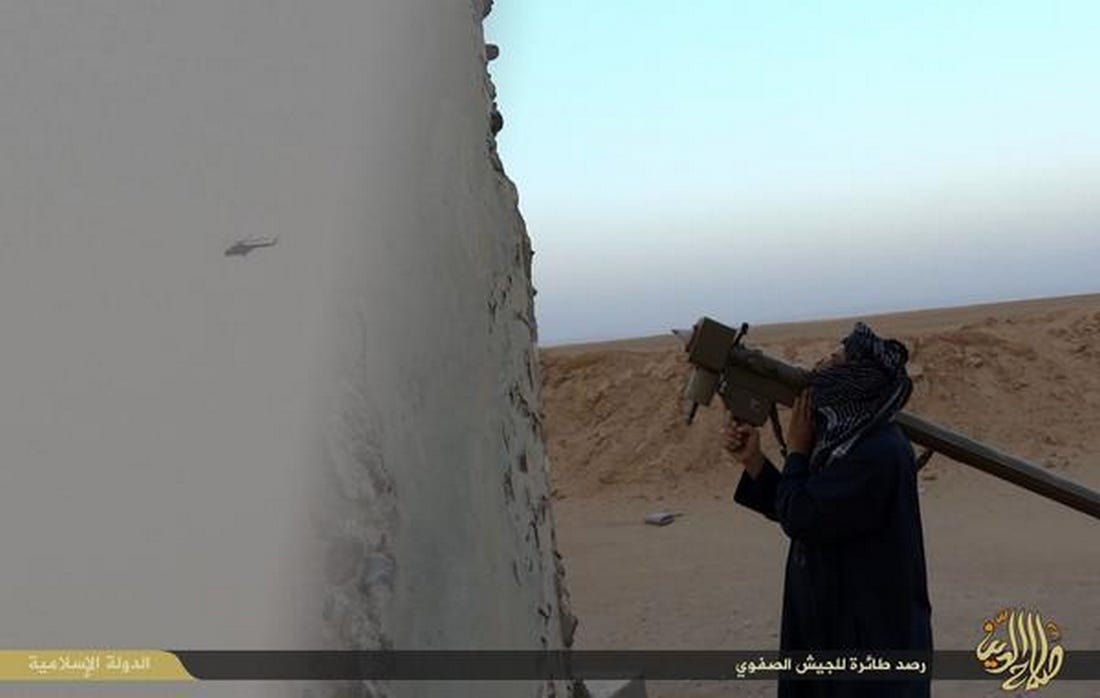Jassem Al Salami
Oct 11, 2014
And knows how to use them
Using advanced targeting systems and long-range precision munitions, U.S., Iraqi and allied aircraft usually manage to stay well beyond the firing range of Islamic State’s anti-aircraft defenses.
But in early October, something changed.
In a three-day span, the militants shot down two high-tech Iraqi helicopters. The first one was an Mi-35M attack helicopter, which fell flaming to the ground on Oct. 3 near Baiji, 130 miles northeast of Baghdad.
The next was an IA-407, an armed reconnaissance version of the Bell 407, which Islamic State fighters downed on Oct. 8, also over Baiji. Four Iraqi aircrew died in the two shoot-downs. Both helicopters carried state-of-the-art jamming devices, including flares and infrared spoofs.
After a few days, Islamic State propagandists posted photos and footage revealing the weapon that militants used to shoot down the two copters. The Chinese-made FN-6 shoulder-fired missile. It’s a lot more dangerous than the Islamists’ usual heavy machine guns.
 Above—a militant with an FN-6 moments before shooting down the Mi-35. Islamic State capture. At top—an Iraqi scout helicopter. Iraqi Ministry of Defense photo
Above—a militant with an FN-6 moments before shooting down the Mi-35. Islamic State capture. At top—an Iraqi scout helicopter. Iraqi Ministry of Defense photo
The FN-6 is a copy of the French Mistral missile. It comes with an all-aspect multi-spectrum seeker to maximize resistance against infrared jammers. The FN-6 has a horizontal range of six kilometers and can hit targets as high as 3,500 meters in the air.
According to The New York Times, Sudan supplied the missiles to Syrian rebels in early 2013. Last year, rebels shot down two Syrian helicopters using the FN-6s—one over Dayr Az Zawr and another at Menagh air base in northern Aleppo.
Islamic State is now in control of both Dayr Az Zawr and Menagh.
Fighter jets are less vulnerable to shoulder-launched anti-aircraft missiles than helicopters are—they can fly above them or outrun them. But helicopters are arguably more useful in attacking the militants, as the rotorcraft can fly low and slow and root out enemy fighters hiding in the terrain.
In other words, effectively attacking Islamic State from the air puts helicopters in the FN-6’s danger zone. That’s a big deal as Iraq acquires more attack helicopters, and U.S. Army Apache copters also get involved in the fighting.
And to be clear—jets aren’t invulnerable to small missiles.
Turkeys’ Hurriyet newspaper claimed that a U.S. Air Force F-15 fighter suffered damage during an air strike on Islamic State in Iraq on Aug. 21. According to the newspaper, Turkish F-16s met up with the damaged F-15 and escorted it to an emergency landing at Batman air base in southern Turkey.
It’s not clear what damaged the F-15—if indeed the incident even occurred. But it would be wise not to rule out Islamic State’s Sudan-supplied Chinese missiles.
No comments:
Post a Comment